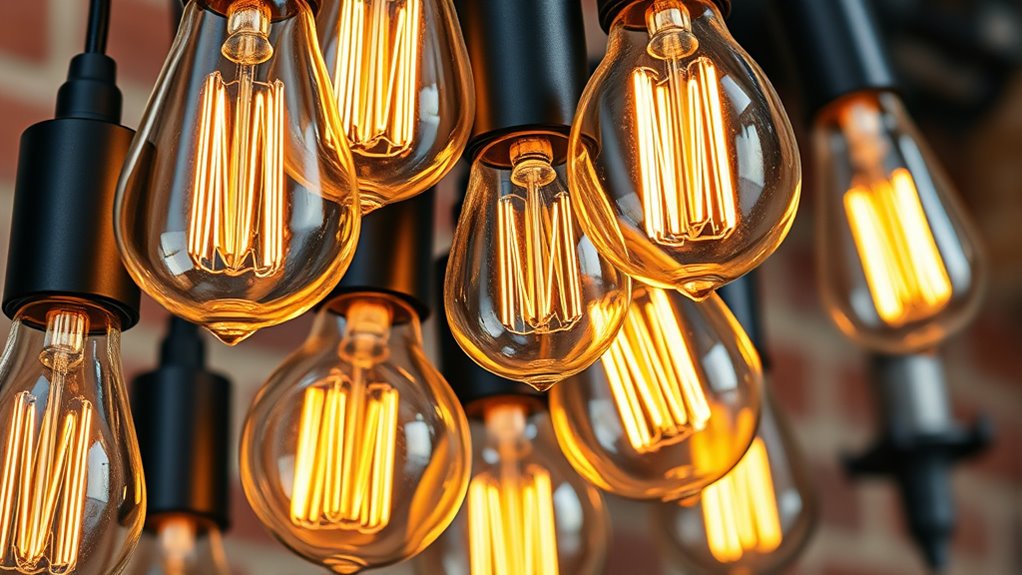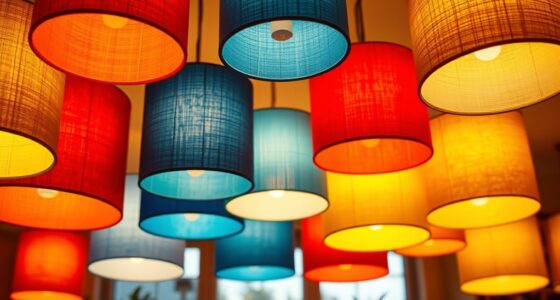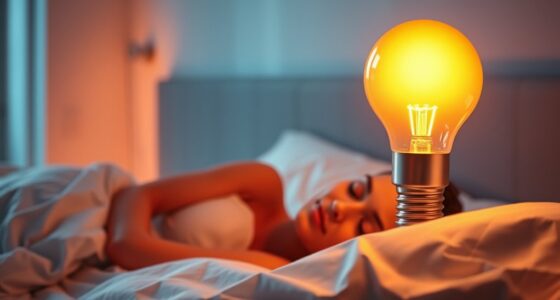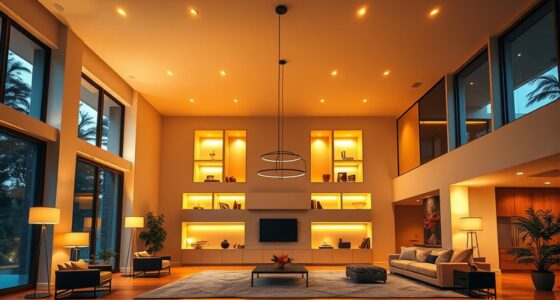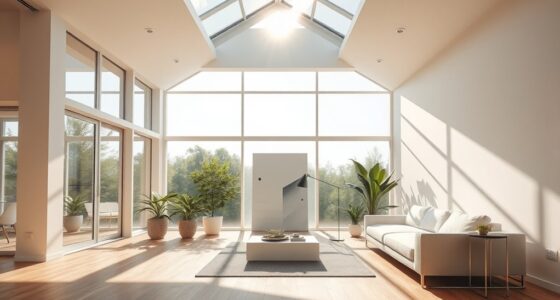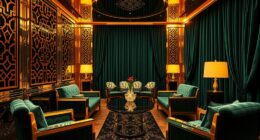Edison bulbs are back in style, but many now are LED impostors that mimic the vintage look. These modern bulbs use LED technology to replicate traditional filaments and warm amber hues while offering better efficiency, longer lifespan, and less heat. This means you get that nostalgic charm without sacrificing performance or sustainability. If you want to discover how to spot authentic-looking options and enhance your space, there’s more to explore ahead.
Key Takeaways
- Many modern Edison bulbs are LED replicas designed to mimic vintage filament appearances.
- These LED impostors offer energy efficiency and longer lifespan compared to traditional incandescent Edison bulbs.
- Authentic-looking LED Edison bulbs feature visible filaments and warm color temperatures for vintage aesthetics.
- They provide the nostalgic charm of vintage bulbs while reducing power consumption and heat output.
- Choosing genuine-looking LED Edison bulbs enhances decor without sacrificing modern performance or sustainability.
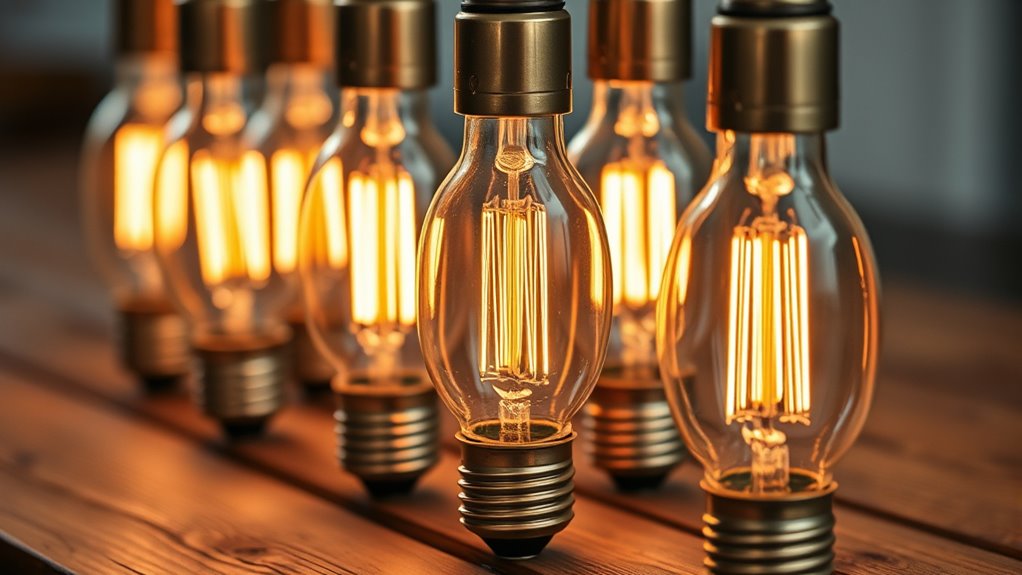
After years of falling out of favor, Edison bulbs are making a stylish comeback. You’ve probably noticed them in trendy cafes, boutique stores, and even chic home decor setups. Their warm, amber glow and distinctive filament design instantly evoke a sense of vintage aesthetics, bringing a nostalgic charm to any space. But the truth is, many of these bulbs you see today aren’t the original incandescent types; they’re LED impostors designed to mimic that classic look. While they promise the vintage vibe, you need to be aware of what’s behind the glass.
Traditional Edison bulbs, with their glowing filaments and warm hues, created a cozy, inviting atmosphere. However, they consumed a lot of energy and burned out quickly, making them less practical for everyday use. The resurgence of these bulbs now often involves LED technology, which offers a more energy-efficient alternative. LED Edison bulbs are engineered to replicate the appearance of the vintage filament, but they use a fraction of the power. This means you get that nostalgic aesthetic without the hefty electricity bills or the frequent replacements.
When you choose LED Edison bulbs, you’re making a smart decision for both style and sustainability. They deliver the same warm, amber glow that old-school bulbs provided, but with enhanced energy efficiency. You won’t have to worry about the filament burning out after a few hundred hours, since LEDs last much longer. Plus, they generate less heat, making your space safer and more comfortable—especially if you have them in enclosed fixtures or around sensitive materials. The energy savings also mean you’re reducing your carbon footprint, aligning your decor choices with eco-friendly principles.
However, it’s important to pay attention to the details. Not all LED Edison bulbs are created equal, and some can look overly modern or lack authenticity. To get the true vintage aesthetic, look for bulbs that feature visible filaments and warm color temperatures. You want a bulb that captures the nostalgic charm of the original Edison style while benefiting from the durability and efficiency of modern LED tech. Additionally, choosing bulbs with cybersecurity considerations ensures your smart lighting setup remains safe from potential vulnerabilities.
In the end, these LED impostors give you the best of both worlds: the vintage aesthetics you love and the energy efficiency you need. They’re a practical upgrade that lets you enjoy classic design elements without sacrificing performance or sustainability. So, when you’re shopping for replacements or new fixtures, consider these LED Edison bulbs—they’re a stylish, eco-conscious way to bring timeless charm into your space.
Frequently Asked Questions
Are LED Edison Bulbs More Energy-Efficient Than Traditional Incandescent Versions?
You’ll find that LED Edison bulbs are more energy-efficient than traditional incandescent versions, offering significant energy savings. They use less electricity to produce the same amount of light, which helps reduce your energy bills. Plus, their lower energy consumption means they have a smaller environmental impact, making them a smarter choice for eco-conscious consumers. So, switching to LED Edison bulbs benefits both your wallet and the planet.
How Long Do LED Edison Bulbs Typically Last Compared to Incandescent Ones?
They say “a stitch in time saves nine,” and that’s true for bulb longevity. LED Edison bulbs last much longer than incandescent ones—often around 15,000 to 25,000 hours—reducing maintenance frequency. You’ll find they need replacing far less often, saving you time and money. In contrast, incandescent bulbs typically last only about 1,000 hours, meaning more frequent replacements and higher maintenance. Choose LED for longevity and efficiency.
Do LED Edison Bulbs Emit the Same Warm Glow as Traditional Bulbs?
You’ll find that LED Edison bulbs can emit a warm glow similar to traditional incandescent ones, thanks to adjustable color temperature settings. For authentic aesthetic appeal, choose bulbs with a lower color temperature (around 2200K to 2700K), which produces a cozy, amber-like light. While some LED versions may slightly differ in warmth, many are designed specifically to match the nostalgic ambiance you seek, making them a great modern alternative.
Are LED Edison Bulbs Compatible With Existing Dimmer Switches?
Imagine trying to tune a guitar string, only to find it’s slightly out of tune—that’s like incompatible dimming switches with LED Edison bulbs. Many LED Edison bulbs aren’t fully compatible with existing dimming compatibility, causing flickering or buzzing. Always check the packaging for dimmer switch compatibility. If your current switch isn’t compatible, upgrading the switch can guarantee smooth dimming and prevent frustration.
What Are the Cost Differences Between LED and Incandescent Edison Bulbs?
When comparing LED and incandescent Edison bulbs, you’ll notice a significant price difference. LED bulbs typically have a higher initial investment, but their long-term savings outweigh the upfront cost. The price comparison shows that LEDs are more expensive initially, but they use less energy and last much longer. So, even though the initial investment is higher, you’ll save money over time due to lower energy bills and fewer replacements.
Conclusion
So, as you shop for vintage charm, remember these LED impostors are like actors in a play—trying to mimic the real thing but missing the soul. They might glow like the classic bulbs, but they lack the warmth and character you truly crave. If you want authenticity, seek out genuine Edison bulbs—because nothing beats the real spark. Don’t settle for a cheap imitation; let your space shine with true vintage style.
